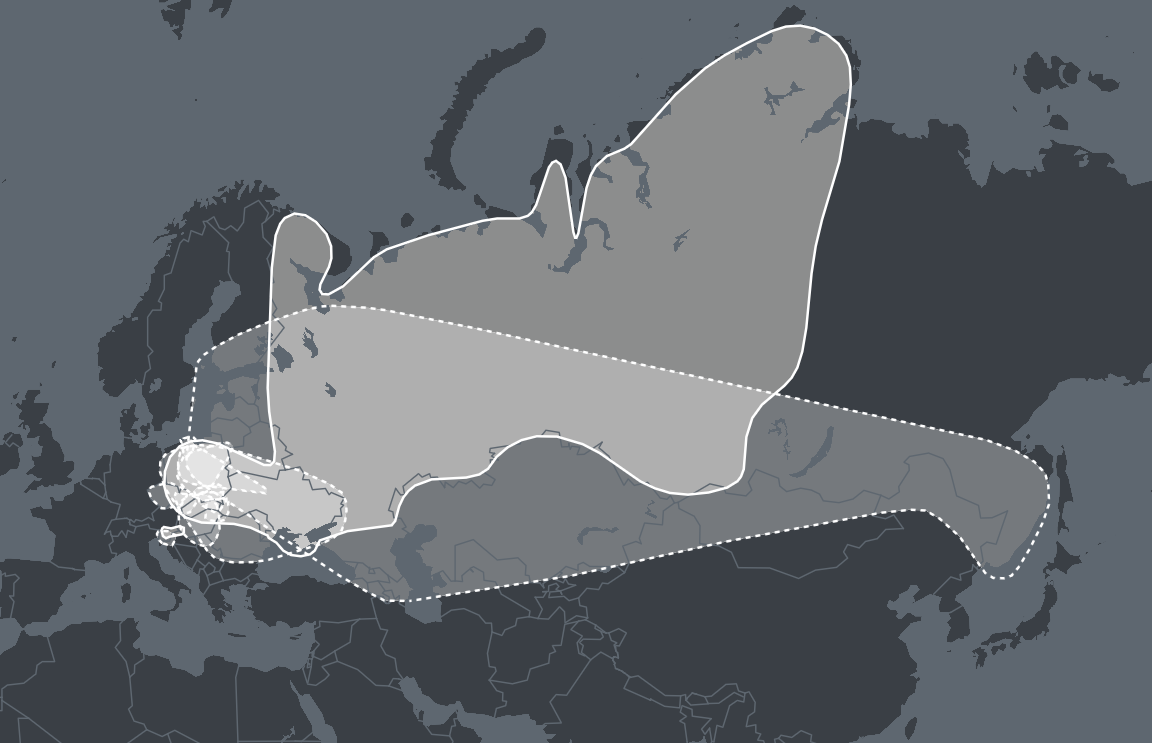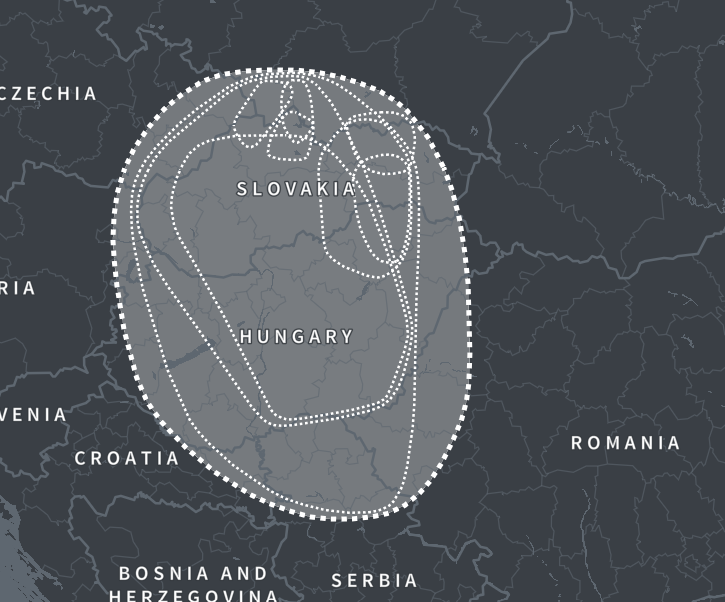What is Eastern Europe and Russia DNA Ethnicity on Ancestry?
The results of our AncestryDNA tests may sometimes be what we expect or on occasion may be a big surprise. Either way, often we need a little more information regarding some of the regions that arise in our ethnicity estimates.

One region that is not at all uncommon is the Eastern Europe and Russia DNA region. Those who still live in this region already understand all about its history and culture. There are others, however, who may never have even visited or in fact been aware that they have ancestors from that area.
In this post we will go into more detail with regards to the history, geography and culture of the Eastern Europe and Russia region. We will also discuss what it means to be from this region and how easy or difficult it might be to trace our roots in the Eastern Europe and Russia Region.
What Is the Eastern Europe and Russia DNA Region?
As the name suggests, the Eastern Europe and Russia DNA region covers a very large area of the eastern section of Europe as well as the vast nation of Russia. A huge number of European countries fall into this massive region including:
- Germany
- Poland
- Czechia
- Austria
- Croatia
- Hungary
- Slovakia
- Serbia
- Bulgaria
- Romania
- Lithuania
- Belarus
- Ukraine
- Moldova
- Latvia
- Estonia
- Georgia
- Finland
- Armenia
- Turkmenistan
- Uzbekistan
- Kyrgyzstan
- Kazakhstan
- Russia
- Mongolia
- China

Eastern Europe and Russia DNA Region Subregions
The Eastern Europe and Russian DNA region is so vast that it has no fewer than 12 subregions, some of which have multiple communities which even further define the areas from which our ancestors may have originated.
Central Poland
The Central Poland subregion as the name suggests focuses on the center of Poland but also extends further to the east into northern Ukraine and southern Belarus. It is made up of 6 further subregions which are:
- Central Poland & Northwestern Ukraine
- Central Vistula Basin
- Greater Poland
- Northern Greater Poland
- Southeastern Pomerania
- West Central Poland
Eastern Czechia
The Eastern Czechia subregion as the name suggests covers most of the eastern portion of the country of Chechia as well as northwestern Slovakia. Within this area there are 4 additional subregions which are:
- Eastern Pardubice
- Southern Olomouc & Southern Moravia-Silesia
- Western Slovakia
- Zlín
Northeast Poland
The Northeast Poland subregion covers much of central Poland as well as the northeastern portion of the nation. It also extends further to the northeast into southern Lithuania and partially into Belarus. As a region it has a further 14 subregions of its own which are:
- Central & Northeast Poland
- Central Ostroleka County
- Central Poland
- Eastern Lomza & Grajewo Counties
- Lodz Province & Surrounding Area
- Northeast Poland
- Northeast Poland & Southwest Lithuania
- Northern Mazovia Province
- Northern Ostroleka County
- Northwestern Podlaskie Province
- Ostroleka County & Surrounding Area
- Plock County
- Southwestern Podlaskie Province
- Western Lomza County
Northeastern Hungary & Eastern Slovakia
The Northeastern Hungary and Eastern Slovakia region as the name suggests originates in eastern Slovakia and northeastern Hungary. Additionally, it extends into southern Poland, western Ukraine and northwestern Romania. As a region it also has 6 further subregions which are:
- Eastern Zemplín
- Eastern Zemplín & Northwestern Transcarpathia
- Northwest Transcarpathia
- Northwest Transcarpathia & Eastern Szabolcs
- Prešov & Košice
- Southern Zemplín & Northern Szabolcs
Northwest Poland
The northwest Poland subregion covers a small area in the central northern coastal regions of Poland. Despite its small size it also has 4 further subregions which are:
- Central Pomerania
- Northeastern Pomerania
- Northern Pomerania
- Northwestern Pomerania
Russians in Eastern Europe
The Russians in Eastern Europe subregion covers a vast area of not just Russia but also the nations of Finland, Estonia, Latvia. Lithuania, Poland, Belarus, Ukraine, Moldova, Georgia, Armenia, Turkmenistan, Uzbekistan, Kazakhstan, and Kyrgyzstan. This subregion also consists of the subregions of:
- Russia
- Southern Russia & the Caucasus
- Ukraine & Belarus
Slovakia & Hungary
The Slovakia & Hungary subregion mainly focuses on the bulk of the two nations of Slovakia and Hungary although it does bleed over to the bordering nations of Czechia, Poland, Ukraine, Romania, Serbia, Croatia and Austria. This region also has a further 9 subregions which are:
- Central Hungary & Central Slovakia
- Eastern Žilina & Lesser Poland
- Northeastern Žilina
- South Poland, Slovakia & North Hungary
- Western Košice & Central Northern Hungary
- Western Prešov
- Western Prešov & Košice & Central Northern Hungary
- Western Slovakia & Central Hungary
- Western Žilina & Silesia

Slovenia & Northwest Croatia
The Slovenia & Northwest Croatia subregion is found in eastern Slovenia and northwest Croatia predominantly but also extends to the north into southern Austria. Although it covers just a small region it does have 3 additional subregions within it which are:
- Croatia Proper
- Gorski Kotar Region
- Slovenia
Southeast Poland
The Southeast Poland region as the name suggests consists mainly of southeastern Poland but does extend south into neighboring Slovakia. Despite being a small region, it is also made up of a further 21 subregions that further defines the region. These are:
- Central Transcarpathia
- Dabrowa County
- Eastern Lesser Poland
- Gorlice & Southern Tarnow Counties
- Jaslo County
- Kolbuszowa County
- Krosno County
- Lesser Poland
- Mielec & Southern Staszow Counties
- Mielec County
- Northeastern Lesser Poland
- Northern Debica County
- Northern Subcarpathia
- Northern Transcarpathia
- Northwestern Debica County
- Southern Debica County
- Strzyzow & Southern Rzeszow Counties
- Tarnobrzeg County
- Tarnow
- Tarnow & Debica
- Western Rzeszow County
Southern Poland & Eastern Slovakia
This subregion is located in southern Poland but it does extend into the neighboring regions of Ukraine, Hungary and Slovakia. It is a compact subregion that also consists of 14 further smaller regions. These subregions are:
- Central Lesser Poland
- Eastern Slovakia
- Eastern Tatras & Stara Lubovna
- Gorlice & Nowy Sacz Counties
- Northeast Slovakia
- Przemysl County
- Sanok County
- Southeast Poland & West Ukraine
- Southeast Subcarpathia
- Southern Jaslo & Gorlice Counties
- Southern Lesko & Bieszczady Counties
- Southern Poland & Northeast Slovakia
- Southern Poland & Northern Slovakia
- Zakopane
Ukrainians in Eastern Europe
The Ukrainians in Eastern Europe subregion pertains mainly to Ukraine but extends to the nearby nations of Belarus, Poland, Czechia, Slovakia, Austria, Hungary, Romania, Bulgaria and Russia. This is a large subregion which includes 7 further smaller regions which are:
- Lviv & Ternopil
- Przemysl & Jaroslaw
- Romania & Southwest Ukraine
- Southeast Poland & Northwest Ukraine
- Tomaszow Lubelski County
- Ukraine & Moldova
- Ukraine & Northeast Romania
Western Czechia
The Western Czechia region is relatively small but focuses mainly on the eastern European nation of Czechia. It does however expand out into neighboring Germany, Poland, and Austria. This region also includes 4 additional regions which are:
- Eastern Plzeň & Western Central Bohemia
- Eastern South Bohemia
- Northern South Bohemia
- Southeast Bohemia & Southwest Moravia
Eastern Europe and Russia Region History
Early Baltics Region
Around 10,000 years ago, as the glaciers began to recede from the land now known as Lithuania and Latvia, hunters and gatherers migrated north from Central Europe. In the early millennia, these tribes roamed this region surviving and subsisting from hunting until the climate gradually warmed.
As the temperatures rose the nomadic tribes started to settle and develop farming practices to help supplement their hunting. The early farms focused on domesticated livestock due to the harsh conditions and poor soil. It wasn’t until the 3rd century BC that the people of the Lithuanian region started to plant crops.
The people who settled this region became known as the Balts and due to the isolation caused by thousands of lakes and swamps for thousands of years, their spread was contained within a relatively small area.
There were several branches of the Baltic tribes, the Old Prussians and Yotvingians in the west and the Lithuanians and Latvians in the east. Today only the Latvian and Lithuanian groups still remain due to historic interference from neighboring regions.

The Lithuanians and Latvians kept themselves distanced from the influences of the Roman empire. They were noted in Roman records, however, from 97 AD in which they were referred to as the Aesti people. Their presence within Europe started to become more recorded after the 2nd century AD in later Roman texts and some early medieval writings.
The Vikings in the Baltics
It was around the 9th to 11th centuries that the Vikings started to raid in the Baltic region. The kings of Denmark would claim tribute from the region with the peoples of Lithuania paying to Kievan Rus. They also paid to the Grand Prince of Kiev, Yaroslav the Wise.
In the mid 12th century, the tables would begin to turn as Lithuanian forces started to band together and raid in their own right. This led to a greater combined force and eventually the early beginning of the Lithuanian State. Later the Latvian and Estonian states would also form as well.
The Balkans Region
Archaeology suggests that the earliest human presence in the Balkans region dates back 11,000 – 6,000 BC. The region is centered around the Danube River in what is now Romania and Serbia. Over the centuries the region developed some of the earliest known European settlements and produced great advances in metallurgy and pottery.
Major settlement activity developed throughout the Balkans region likely stemming from these early humans who first settled around the Danube River. These early civilizations likely shared common languages and traditions.
It wasn’t until later starting around 1,000 BC when the Greeks entered their Dark ages and their region essentially splintered that the Balkan region saw interference from the outside world. Greek Settlements moved further north on Aegean peninsula coming into closer contact with the peoples of the Balkans.
In the 4th Century BC Alexander the Great of Macedon, through his building of an empire, opened up the routes of trade into the Balkans greatly influencing the area.

In the 2nd Century the Balkan region also saw great influence under the Romans. They annexed much of the region making it one of the most prosperous areas for the Empire. As with much of the Roman empire this brought a great deal of settlement and likely had an impact on the DNA we know today as the Balkans region.
Early Germanic Europeans
The early inhabitants of the Germanic European region were somewhat surprisingly the Celts. We often think of the Celts as being associated with the British Isles but in truth rather than being a singular people, they were a wide-ranging group of different tribes.
Spread throughout Europe, the Celtic tribes were first described by the Romans in the 7th and 8th centuries BC. The Celtic tribes controlled most of the European continent by the 3rd century BC ranging all the way to Ireland in the West. As the culture declined Ireland in fact remained one the last strongholds of Celtic culture.
It is likely that Celtic tribes were living in the region we know today as Germany for around 2600 years before being driven out by Germanic tribes to the North and under pressure from the Romans in the south.
As the Celts shifted to the west their place was taken by the Germanic tribes such as the Huns and Visigoths who came from Scandinavia. These Germanic tribes were fierce fighters and served somewhat as a roadblock for the Roman advance north.
Because the Germanic tribes held fast against the Roman empire there was little impact from the Romans in terms of DNA.
How Did You Get Eastern Europe and Russia Region DNA?
If you already know that you had family who came from Eastern Europe and Russia, then you know why you have Eastern Europe and Russia region DNA. If this result came as a surprise, you may not know how exactly you came by DNA from this region.
If you have a sizable percentage of DNA from this region, then it is likely you have an ancestor who was born in or close to the country of Eastern Europe and Russia.
Is the Result Accurate?
When it comes to ethnicity estimates, the higher the percentage you have from a certain region the more likely it is to be accurate. If your percentage is low, however, then it is harder to pinpoint exactly where your most recent ancestors came from.
A low result could mean a distant ancestor from that region. It is best to focus on your highest rated region's matches to determine where your ancestors came from more recently. A low percentage can often be hard to locate because the ancestor in question could be many generations back in your tree.
How to Research my Ancestry from These Regions
The results of a DNA ethnicity test are of course a great place to start, especially if there is an unexpected result found in the report. As always of course DNA cannot tell the whole story and we need to actually do the research work.
A percentage on an ethnicity estimate means very little unless you follow through and start building up your family tree. The relevant ancestors may be several generations back and it may take a lot of research to discover who they were.
If you have specific regions mentioned in your report, then you have a good idea of where your ancestor may have originated from. Ancestry DNA even has migratory information from some of these regions through to the final settlement places in the United States or elsewhere in the world.
Using Ancestry, you may be able to determine not only who your ancestors were from the British Isles but perhaps the reason they decided to move.
Final Thoughts
The Eastern Europe and Russia Region is a massive and complex group that has seen a great deal of crossover between regions which has led to a common DNA signature within its populous and their descendants at large. Influences from Germanic, Baltic and Balkan tribes as well as many other European groups have gone into the DNA that connects this region.
There are over 100 subregions in this vast region which can help you more accurately pinpoint where in Eastern Europe and Russie your most recent ancestors may have been born.
Link To or Reference This Page
We spent a lot of time downloading, cleaning, merging, and formatting the data that is shown on the site.
If you found the data or information on this page useful in your research, please use the tool below to properly cite or reference Name Census as the source. We appreciate your support!
-
<a href="https://namecensus.com/blog/what-is-eastern-europe-and-russia-dna-ethnicity-on-ancestry/">What is Eastern Europe and Russia DNA Ethnicity on Ancestry?</a>
-
"What is Eastern Europe and Russia DNA Ethnicity on Ancestry?". NameCensus.com. Accessed on May 4, 2024. https://namecensus.com/blog/what-is-eastern-europe-and-russia-dna-ethnicity-on-ancestry/.
-
"What is Eastern Europe and Russia DNA Ethnicity on Ancestry?". NameCensus.com, https://namecensus.com/blog/what-is-eastern-europe-and-russia-dna-ethnicity-on-ancestry/. Accessed 4 May, 2024
-
What is Eastern Europe and Russia DNA Ethnicity on Ancestry?. NameCensus.com. Retrieved from https://namecensus.com/blog/what-is-eastern-europe-and-russia-dna-ethnicity-on-ancestry/.
